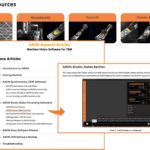
Are you interested in observing your catalyst selectivity while seeing nanoscale changes? The selectivity of the catalyst is often determined by surface groups, catalyst location and interaction with support materials. In other words, the catalyst selectivity is a nanoscale process. Protochips’ Atmosphere AX system can help in understanding catalyst selectivity by visualizing the nanoscale reactions, while being able to analyze the gas stream simultaneously. Atmosphere AX gives many more options to correlate changes at the nanoscale, in real time, at 1 atmosphere with several gasses and vapors and even using heating! So how are you able to observe the selectivity of your catalyst using our systems?
- Preparation: It is important to get an in situ holder in the microscope, without leaking gasses in the system. This is why the Atmosphere AX system comes with proactive pressure monitoring and will shut the system down if a leak is found! Moreover, the system consists of a permanently places holder tip to increase the lab safety and ease of maintenance/cleaning.
- Collection: When we are safely in the microscope, the gas flow and heating can be started. However, with heating and gas flow comes movement! While imaging in the TEM our machine vision software, AXON Synchronicity, provides live stabilization and metadata indexing and integration.
- Analysis: If we truly want to analyze the catalyst selectivity, we need to be able to control the gasses coming into the system. Using volumetric blending can create gases with varying molecular weights and you can even use and detect organic vapors such as benzene.
- Publishing: As most labs have an international focus, it is possible to share complete datasets using the AXON Studio software, with all the metadata included. AXON can even be used as an electronic lab journal, where any type of file can be included and packed and shared easily.
Using this workflow you are guaranteed to be able to scale your bulk catalysts experiments to the nanoscale, while doing this productively and reproducibly and being able to share and filter data easily using the FAIR principle methods.
Want to know more about heterogeneous catalysis using in situ microscopy? Look up our brochure online!
In the below images you can see how in situ EELS and in situ STEM can help identify how Pt nanoclusters and single atoms on Pt/CeO2 catalysts significantly influence the selectivity of H2 reactions. The study provided new insights into promoted CeO2 surface reactions with H2.

Find the entire research study paper here:









